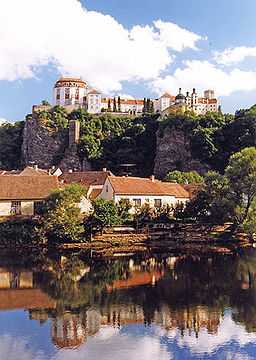Vranov nad Dyjí Chateau
| Vranov nad Dyjí | |
| Chateau | |
 | |
| Country | Czech Republic |
|---|---|
| Region | South Moravia |
| District | Znojmo |
| Municipality | Vranov nad Dyjí |
| Elevation | 312 m (1,024 ft) |
| Coordinates | 48°53′41″N 15°48′45″E / 48.89472°N 15.81250°ECoordinates: 48°53′41″N 15°48′45″E / 48.89472°N 15.81250°E |
| Author | Johann B. Fischer of Erlach Anton Erhard Martinelli |
| Style | Baroque (parts in Gothic and Renaissance) |
| Material | stone, brick |
| Founded | c. 1100 |
  Location in the Czech Republic
| |
| Website: Vranov nad Dyjí State Chateau | |
Vranov nad Dyjí is a château in the homonymic town of Vranov nad Dyjí in the South Moravia (South Moravian Region), Czech Republic. It lies on the Dyje (Thaya) river, 3 km (1.9 miles) north from the Austrian border close to Hardegg.
History

.jpg)
Vranov's location was first mentioned by Cosmas of Prague in 1100 as a border sentry castle (oppidum (et) castrum Wranou). It was built by Dukes of Bohemia for defending the south border of Moravia against raids from neighbouring Austrian March. Until 1323 the castle had remained in royal hands but in this year king John of Bohemia pawned Vranov to powerful Bohemian nobleman, viceroy Jindřich of Lipá.
During disturbances of the Hussite Wars Bohemian noble family of Lichtenburg took control over the castle and contiguous market town (1421). In 1499 was it definitely passed on to Lichtenburgs as hereditary possession by the king Vladislaus II of Bohemia and Hungary. Lichtenburg family held Vranov almost for one century, until 1516.
In the 16th century, Vranov frequently changed the holders (chronologically: lords of Boskovice, Pernštejns, lords of Lomnice, Kraigers of Krajk and Dietrichsteins). Probably the most significant owners were lords from the Bavarian family of Althann, cousins of the Princes of Belmonte. Wolf Dietrich of Althann purchased the castle in 1614. Nevertheless seven years later the manor was confiscated due to his participation in the rebellion of the Bohemian Estates. Confiscated castle was consequently sold to one of the Valdštejn's general Johann Ernst of Scherfenberg.